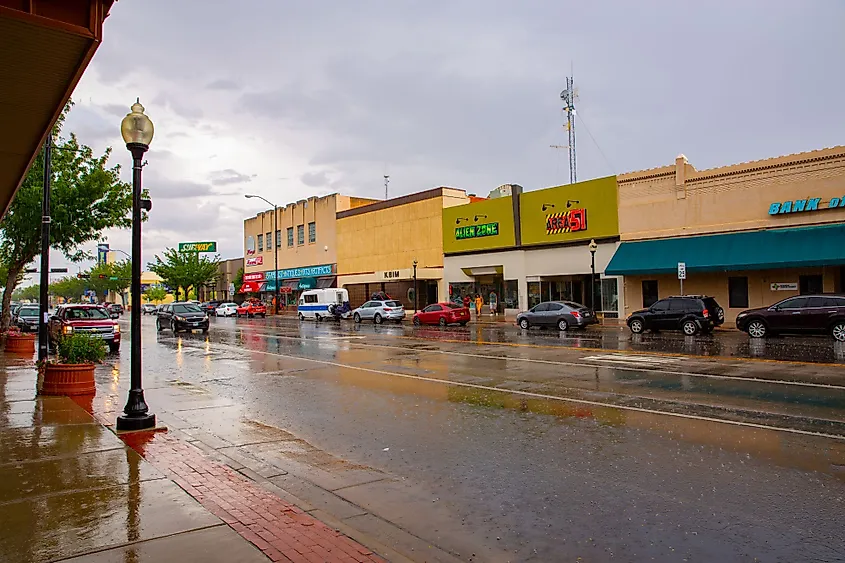
Roswell, New Mexico
Roswell, the county seat of Chaves County, is a small city situated in the High Great Plains in the southeastern portion of the US state of New Mexico. Established in 1871 as a trading post by a Nebraskan businessman Van C. Smith, and named after his father, Roswell Smith, the town quickly grew. Recipient of the All-America City Award several times, Roswell’s economy is primarily driven by New Mexico and American tourism with many museums and businesses on aerospace engineering and ufology.
Geography and Climate of Roswell

Roswell is approximately seven miles west of the Pecos River and 40 miles east of the highlands rising to the Sierra Blanca range. The city covers a total area of 29.9 square miles, of which 29.8 square miles is land and 0.04 square miles is water. From Roswell, the US Route 70 Highway leads 110 miles northeast to Clovis and 118 miles west to Alamogordo, whereas the US Route 285 Highway leads 191 miles north to the state capital Santa Fe and 76 miles south to Carlsbad. The US Route 380 Highway leads 164 miles to Socorro and 130 miles to the city of Brownfield in Texas. The Bottomless Lakes State Park is approximately 16 miles east, and the Bitter Lake National Wildlife Refuge is a few miles northeast of Roswell.
Due to the city’s location in the High Plains as well as the Chihuahuan Desert, Roswell experiences a semiarid climate, as per the Koppen Climate Classification. The city has hot summers and short, cool winters. July is the hottest month, with average temperatures ranging between 94°F and 69°F. December is the coolest month, with average temperatures ranging between 30°F and 57°F. The city receives an average precipitation of 11.63 inches.
Brief History of Roswell

A group of pioneers from Missouri were the first non-indigenous settlers in the area around present-day Roswell in 1865. However, these settlers had to abandon the site due to a lack of water. In 1869, a Nebraskan businessman named Van C. Smith and his partner Aaron Wilburn built two adobe buildings in the area, which became the settlement’s post office, general store, and sleeping quarters for paying guests. On August 20, 1873, after becoming the town’s first postmaster, Smith named the town after the first name of his father, Roswell Smith, a well-known lawyer from Lafayette, Indiana.
Initially established as a trading post, the town gradually developed as a ranching and agricultural center. The discovery of a major aquifer in 1890 led to the first significant growth and development of the area, which continued until the arrival of the Pecos Valley Railroad in 1892. Roswell’s economic growth was further stimulated by the Walker Air Force Base’s establishment in 1941 and the discovery of oil and natural gas in 1950. Moreover, the area attracted more tourists after the recovery of the debris of a military balloon that crashed near the city in 1947, with several conspiracy theories claiming it to be the debris of an extraterrestrial spacecraft and its alien occupants.
Population and Economy of Roswell

As per the latest US Census, Roswell has a population of 48,422 inhabitants, making it New Mexico’s 5th largest city. The top ethnic groups in Roswell include White (Hispanic) at 43.9%, White (Non-Hispanic) at 35.6%, Other races (Hispanic) at 7.91%, Two and more races (Hispanic) at 6.51%, and African American (Non-Hispanic) at 1.7%. As of 2019, about 19.7% of the city’s population lives below the poverty line.
Roswell has a median household income of $45,493 and a median property value of $110,000. The economy of Roswell employs about 20,100 people. The biggest industries in Roswell include Health Care & Social Assistance, Retail Trade, and Educational Services. The largest universities in the city include the Eastern New Mexico University (Roswell campus) and New Mexico Military Institute.
Attractions in and Around Roswell
International UFO Museum and Research Center

Dedicated to the alleged 1947 Roswell incident, this museum and research center is in Roswell's downtown district. Established in 1991 and housed in an old movie theatre, the museum contains a library and a collection of exhibits that tells stories about the history of all the UFO encounters. The museum serves as the centerpiece of the UFO fest held in Roswell annually.
Roswell Museum and Art Center

Established in 1936, the Roswell Museum and Art Center houses an extensive collection of art from the American Southwest. The center also maintains an exhibit which is a recreation of the American engineer Robert H. Goddard’s rocket engine development.
POW/MIA Park
Formerly referred to as Iron Cross Park, the POW/MIA Park displays an outline of an iron cross created by the German prisoners of war, who used to perform major infrastructural works in Roswell. The park also displays a piece of the Berlin Wall that the German Air Force gifted to the city of Roswell.
The Pioneer Plaza, as well as other parks located in and around the city, hosts music performances by local artists. Moreover, the Bottomless Lakes State Park, located to the southeast of Roswell, features nine small lakes along the Pecos River Valley’s eastern escarpment. The park also houses several endangered species, including the Eastern Barking Frog, the Pecos pupfish, Rainwater Killifish, and the cricket frog.











